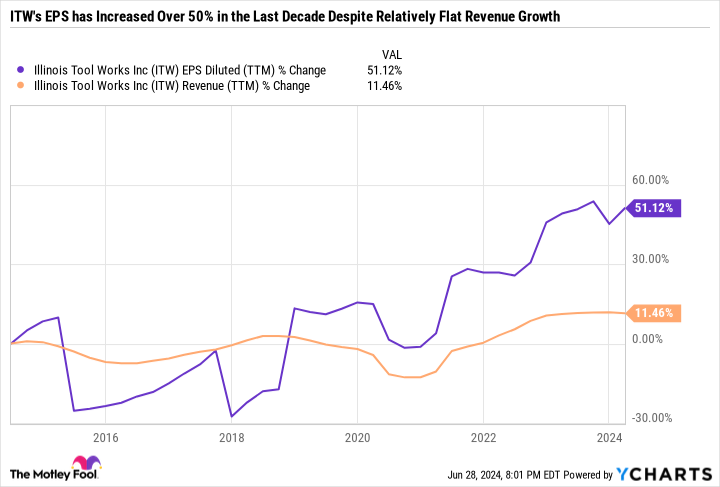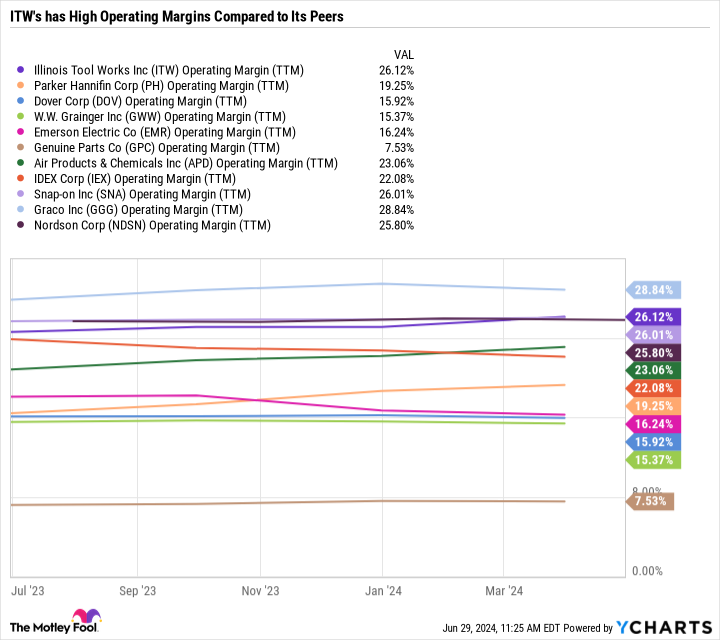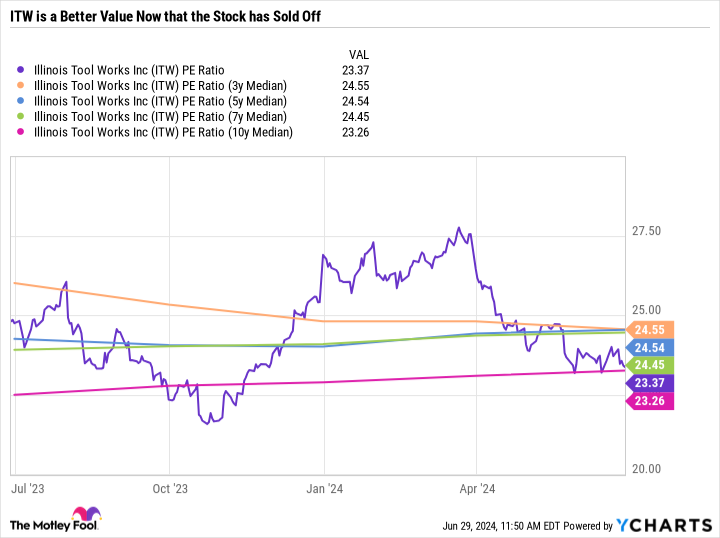Dividend stocks can be excellent investments to generate passive income. The best dividend-paying companies have sustained earnings growth and in turn increase their payouts to shareholders. The elite among them may eventually gain entry into the Dividend Kings category — companies that have increased their payouts annually for at least 50 consecutive years.
Besides being a Dividend King, PepsiCo (NASDAQ: PEP) has a yield of 3.3% at the current share price, which is high compared to the average yield of 1.3% for the S&P 500It also has a fairly recession-proof business, making it exactly the kind of consistent company that many risk-averse income investors are looking for.
Pepsi is a top dividend stock and a household name to most consumers, but the lesser known Illinois Tools Works (NYSE:ITW) might be an even better Dividend King to buy now.

Getting to know ITW
Illinois Tool Works, also known as ITW, is a global industrial conglomerate with a diversified product portfolio spanning multiple industries. The company primarily sells products to businesses, so it would be understandable if you are unfamiliar with many of its brands.
It does not make huge earthmoving machines or very complex machinery. Many of its products function as role players in larger systems. Here is an overview of its segments and some product examples.
|
Segment |
Product examples |
Turnover 2023 |
Operating margin 2023 |
|---|---|---|---|
|
Automotive |
Fasteners, interior and exterior components, driveline components |
$3.2 billion |
17% |
|
Testing & Measurement and Electronics |
Laboratory test and assembly equipment, accessories, consumables, aftermarket parts and services |
$2.8 billion |
24% |
|
Food equipment |
Advanced washing and cleaning equipment, services, cooking, cooling and food processing equipment |
$2.6 billion |
27% |
|
Building products |
Fixed solutions, additional fasteners and accessories, building design and engineering software |
2 billion dollars |
28% |
|
Welding |
Welding equipment, special consumables, safety solutions |
$1.9 billion |
32% |
|
Polymers and liquids |
Technically developed adhesives, sealants, coatings, lubricants, additives, windscreen wiper blades, cleaning agents |
$1.8 billion |
27% |
|
Special products |
Zippers and six pack rings for packaged goods, medical devices, aircraft ground support equipment, coating and metallization companies for product branding and national security markets |
$1.7 billion |
27% |
Data source: Illinois Tool Works.
One thing that sets ITW apart from other industrial conglomerates is that none of its seven segments dominates the revenue mix. And apart from automotive, which is struggling in North America but growing rapidly in China, all of its segments have excellent operating margins. The company as a whole posted an operating margin of more than 25% in 2023.
Management expects an even better operating margin of 26% to 27% in 2024 and an operating margin of 30% in 2030.
Concerns about growth
The biggest challenge for ITW is sluggish organic growth. Organic revenue fell 0.6% last quarter. ITW is forecasting just 1% to 3% organic growth for the year and 2% to 4% revenue growth. Earnings per share (EPS) are expected to be slightly better, growing 6% to 10% for a total of $10.30 to $10.70 in full-year EPS — thanks in part to a one-time accounting change.
Zoom out a bit further and you’ll see that ITW’s earnings per share have grown just 20.6% over the past three years. That’s not a terrible growth rate for a staunch dividend payer, but it’s not exactly great either. Revenue has grown even slower, at 14.7%. Look at an even longer period, however, and you’ll see that earnings have grown much faster than revenue — evidence that ITW has become a more efficient, higher-margin company.


A leaner business with wider margins is better than an overextended model that relies heavily on revenue growth at the expense of margins. But ultimately, ITW will have to chart a path to both wider margins and higher revenues, especially since there is a limit to the number of efficiencies a company can make.
If you tune in to a typical ITW earnings call, you’ll notice that much of the conversation revolves around margins. It may seem trivial to go back and forth about a single percentage point in margins. But ITW generated $16.1 billion in revenue over the past 12 months and $4.2 billion in operating income — so every percentage point change in margin equates to a $160 million difference in operating income.
Because ITW is involved in so many different industries (and generates a significant amount of revenue from outside North America), no company is an exact competitor. However, some companies compete with ITW in one or more segments. And ITW has significantly higher margins than many of these peers.


Despite the lower income than Original parts, Parker Hannifin, WW GraingerAnd Emerson ElectricITW has the highest operating income of any company on this list. What makes it such a special company is that it combines size with wide margins across many different product categories. Conglomerates can often be large and inefficient, but ITW is a great example of an effective conglomerate that benefits from diversification.
Expect a dividend increase soon
Last August, ITW announced a 7% dividend increase to $1.40 per share per quarter. ITW typically announces its annual dividend increases in the summer, with the first affected payment occurring in October. Given the consistency of its dividend program, investors can expect an announcement sometime in the next few months.
Not all Dividend Kings use share buybacks as their primary way to return capital to shareholders, but ITW plans to buy back $1.5 billion of its stock this year. For comparison, it paid out $418 million in dividends last quarter — or about $1.7 billion over the past year. So on the surface, ITW’s 2.4% yield might not seem super attractive, but its capital return program is much stronger once you factor in the buybacks.
High margins help ITW squeeze more profit out of every dollar of revenue. But by buying back shares, the number of shares is reduced, which leads to higher earnings per share. Over the past five years, the company has reduced its outstanding shares by 7.8%, which has increased earnings per share by 36.1%, while net income has increased by 24.2%.
Buybacks have also helped keep ITW’s valuation in check. The stock’s recent sell-off, coupled with steady earnings growth, has pushed its price-to-earnings (P/E) ratio down to just 23.4, below the three-, five-, and seven-year median P/E ratios. And ITW was trading above these key levels just a few months ago.


ITW is a versatile purchase
ITW is a phenomenal company, but its valuation was expensive and its revenue growth has been weak. Now that the shares have been sold, the conglomerate’s only bad thing is its low revenue growth.
There are almost perfect companies, but there is no such thing as a perfect stock. The best companies tend to be expensive relative to their underlying or expected earnings, while bad companies trade cheaply for good reasons.
However, ITW is almost a perfect blue chip dividend stock. It is an extremely efficient company with high margins, a 50+ year track record of increasing dividends, a significant buyback program, and a reasonable valuation. The conglomerate model works well for ITW and helps the company offset much of the cyclicality of its various end markets.
When you add it all up, there is a lot to like about ITW as a top-notch Dividend King that you can buy and hold for years to come.
Should You Invest $1,000 In Illinois Tool Works Now?
Before you buy Illinois Tool Works stock, you should consider the following:
The Motley Fool Stock Advisor team of analysts has just identified what they think is the 10 best stocks for investors to buy now… and Illinois Tool Works wasn’t one of them. The 10 stocks that made the cut could deliver monster returns in the years to come.
Think about when Nvidia made this list on April 15, 2005… if you had $1,000 invested at the time of our recommendation, you would have $757,001!*
Stock Advisor offers investors an easy-to-follow blueprint for success, including portfolio building guidance, regular analyst updates, and two new stock picks each month. The Stock Advisor has service more than quadrupled the return of the S&P 500 since 2002*.
View the 10 stocks »
*Stock Advisor returns as of June 24, 2024
Daniel Foelber has no position in any of the stocks mentioned. The Motley Fool has positions in and recommends Emerson Electric. The Motley Fool has a disclosure policy.
Pepsi is a rock-solid dividend king, but so is this blue-chip stock, which is down 12% in the past 3 months. Originally published by The Motley Fool







